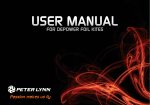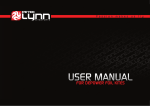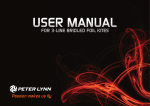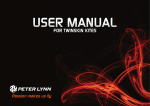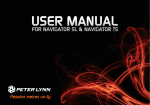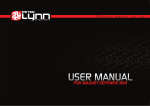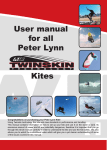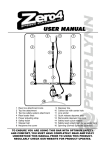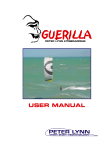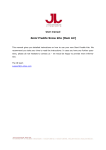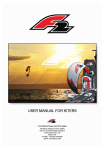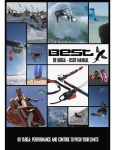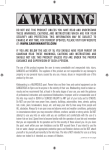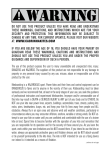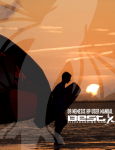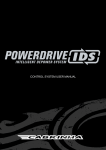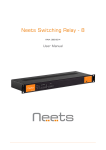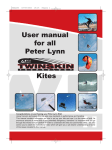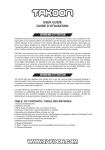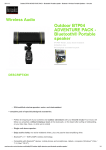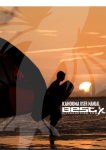Download 4-line LEI manual
Transcript
WELCOME Thank you for buying this Peter Lynn product, and welcome to the World of Peter Lynn, a world of wind driven excitement, where people passionately pursue their dreams whether that’s freeriding at a local beach or enjoying the virgin snow on a back country adventure. Peter Lynn is there to help them pursue their dreams, Peter Lynn is here to help you pursue your dream, making you achieve your ultimate challenge. Are you ready? Peter Lynn has been there taking challenges from the early days of the sport. Challenges to develop breakthrough ideas, make better products, improve performance and quality in all aspects of those products. We have the right kites for all kite disciplines, for any terrain and for all conditions. All this is realized by a passionate crew of kite sports enthusiasts and we invite you to join us. It’s that passion that makes us fly. Before any attempt to use this product, please ensure you pay full and careful attention to the contents of this manual. While traction kiting is an exciting and fun sport, it can be highly dangerous, especially if not all the necessary safety precautions are taken. So please make sure you learn this great sport in a safe way. Only then will you progress quickly and enjoy this beautiful sport to the max. Enjoy! SAFETY INSTRUCTIONS CAUTION: Kite powered sports can be very dangerous and physically demanding. The user of this product should understand that participating in kite powered sports may involve serious injury or death and agrees to observe the safety precautions listed below. Safe location and weather conditions: • Stayawayfrompowerlines,roads,airfields,railwaylines,treesandbuildings. • Neverlaunchyourkiteincrowdedareas.Donotflyyourkiteoverbystanders. • Makesurethereisa‘clear’downwindareaatleastthreetimesthedistanceof your flying line length. • Neverflykitesorusethisproductinthunderstorms,lightningorgusty/stormy winds. • Neverflyakiteorusethisproductwithwindforcessostrongthatyouareunable to maintain full control of your kite and its power at all times. • Donotflyakiteorusethisproductwhenwindconditionsarelikelytochange dramatically. • Stopkitingimmediatelywhenastormorlightningisapproaching. • Makesureyouarefamiliarwiththelocationandlocalcustomsandlawsbefore attempting any kind of kite sports. Safe traction kiting: • Atractionkiteisnotatoyandshouldnotbeflownbyinexperiencedpersons and certainly not by children. • Learntoflykitesbystartinginlightwindswithasmallsizedkite. • Neveruseanytypeofkiteorthisproductforparagliding,parachutingorbase jumping. • Neveruseanytypeofkiteorthisproductforjumpingoffhighplaceslikehillsor cliffs • Neveruseanytypeofkiteorthisproductforanymanliftingactivity. • Alwaysusefullyprotectivegearwhenkiteboarding,landboarding,snowkitingor buggy riding. Safe kiteboarding: • Donotgokiteboardinginoffshorewinds. • Becarefulwhenkitinginonshorewinds. • Westronglyrecommendtheuseofhelmetandlifejacket/impactvest.Asafety knife to cut flying lines in case of emergency is recommended. • Donotkiteboardinspotsalreadyinusebyswimmersorsurfers. • Bewareofstrongcurrentsandsharks. • Staysafelyawayfromotherwatercraftsandshippinglanes. • Nevergofurtherouttoseathanyoucansafelyswimback. • Always make sure there is a capable person on shore that is keeping watch and is ready to provide (or call for) help in case of an emergency. • Westronglyrecommendtakinglessonsfromacertifiedkiteboardingschool before using this kite on your own. Safety issues when using this product: •Thiskitehasbeenmanufacturedwithhighqualitymaterialsandhasbeenmanufactured using the latest and most advanced production methods. • Priortoeveryuseofthisproduct,fullycheckyourequipmentforanysignsof wear and tear. Replace parts immediately where needed. • Priortoeveryuseofthisproduct,checkifyoursafetyreleasesarestillworking properly and you are aware how to use it. In case the safety release does not work as it should, do not use this product and replace parts where needed. • Onlyusethisproductforkiteboarding,buggyriding,landboardingandsnowkiting. • Donotusethisproductwhenyourbodyweightisover130kg(285lbs). • Onlyusethisproductwhenyouareinagoodstateofhealth.Neverusethis product when under the influence of alcohol, drugs or medication. • Donotalter,modifyorchangethisproduct.Repairsshouldbedonebyaprofessional kite repair shop, sail repair shop, or by the Peter Lynn company. THE WIND WINDOW EDGE OF WIND WINDOW MINIMUM POWER POWER ZONE MAXIMUM POWER Beforeflyingyourkiteitisveryimportanttounderstandthe‘windwindow’. The image shows where the kite will create the most power (straight downwind, alsoknownasthe‘powerzone’)andwherethekitewillcreatetheleastpower (edge of the window and zenith). 2 3 TERMINOLOGY 1 2 3 4 1 4 2 3 5 6 9 8 10 12 12 13 15 14 17 13 16 18 19 20 23 22 21 23 24 25 26 1. Kite’sleadingedge 2. Leftbridle 3. Rightbridle 4. Left rear line attachment point 5. Lefttoplineattachmentpoint 6. Right top line attachment point 7. Right rear line attachment point 7 8. Leftrearflyinglineattachmentpoint 9. Left top flying line attachment point 11 10. Righttopflyinglineattachmentpoint 11. Rightrearflyinglineattachmentpoint 12. Uppersegmentoftopflyingline 13. Attachmentpointconnectingtopline segments 14. Lowersegmentoftopflyingline 15. Leftrearflyingline 16. Rightrearflyingline 17. Toplineconnectionpoint 18. Centertopline 19. Safetyline 20. Leftleaderline 1 2 3 21. Rightleaderline 22. Poweradjuster 23. Self-landinghandle/Kiteflag-outhandle 24. ControlbarwithcolourcodedEVAfoam 25. Centrixpush-awaydepowerloopwith primary quick release 26. Safetyleashwithsecondaryquickrelease 5 6 10 7 8 11 9 12 12 13 1. Inflatevalve 2. Pumpleashattachment 3. Deflatevalve 4. Leading edge 5. Singleinflationairduct 6. Canopy 7. Trailingedge 8. Lefttoplineattachmentpointwithpulley 9. Struts 10. Righttoplineattachmentpointwithpulley 11. Barpressureadjustment 12. Top/rearlineadjustment 13. Leftrearlineattachmentpoint 14. Rightrearlineattachmentpoint 14 STARTING OFF STEP 1. FINDING THE RIGHT LOCATION TO LAUNCH YOUR KITE Tostartflyingyourkiteyouneedtofollowthesefivesteps: Step1.Findingtherightlocationtolaunchyourkite Step2.Pumpingupyourkite Step3.Settingupyourbarandlines Step 4. Checking your safety system Step5.Launchingyourkite Findaspottosetup,awayfromairports,powerlines,treesandbuildings.When launching, the area should be free of kiteflyers or other people. Also make sure there are no sharp objects on the ground, to prevent any damage to your kite. STEP 2. PUMPING UP YOUR KITE Place your kite on the ground with its leading edge into the wind, the bottom of the kite facing upwards. Attach the pump leash to the kite’s pump leash attachment. Makesurethedeflatevalveisclosed andsecuredwiththeVelcrotagand bungee chord. Attach the pump hose to the inflate valve. Makesuretheclipsontheairducts leading to the struts are all open. Start pumping until the leading edgefeelsfirm.Ifyouprefertousea pressure gauge, pump until it reaches about 6 psi. Detachthepumpandclosetheinflate valve. Close the clips on the air ducts. This will prevent the whole kite from losing pressure in case of a puncture. Place the kite on the ground with the top of the kite facing up, leading edge into the wind. Weigh down the canopy with some sand or a board withfinsfacingup. STEP 3. SETTING UP YOUR BAR AND LINES Starting downwind of the kite, unwind your flying lines while walking downwind. Place your bar on the groundthewrongwayaround.Make sure your leader lines and other parts of the bar are free of tangles or twists. Holdyourlinesbetweenyourfingers while walking back toward the kite, to sort out the flying lines. Place all lines on the ground. Attaching the top lines to the kite BRIDLE FLYING LINE Attach the flying lines one by one, using larkshead knots. Attaching the rear lines to the kite BRIDLE FLYING LINE Check that your bridles are free of tanglesandtwists.Makesurethepulleys are free of sand. BRIDLE FLYING LINE Makesureyouattachyourflyinglinesusingalarksheadknot.Placealarkshead knot in the flying line connector, slide it over the middle knot on the top line attachment on the bridle and tighten the larkshead as shown. BRIDLE FLYING LINE BRIDLE BRIDLE FLYING LINE FLYING LINE Connect the flying line connector to the rear line attachment and tighten the larkshead as shown. STEP 4. CHECKING YOUR SAFETY SYSTEMS Before using this kite, please check the manual supplied with your bar on how to activate your safety systems and re-attach the release systems used. Werecommendtotestthesafetysystemwhenusingthekiteforthefirsttime so you are aware how the system works, how to activate it and how to re-attach it after activating. The safety system works in two steps: Primary safety - If you need to lose the power of the kite without losing the kite itself the primary safety release can be used. The kite loses its power but is still connected to the rider by the safety leash. Secondary safety release - When the kite is still pulling after using your primary quick release, use the secondary release on the leash. Neverbeafraidtouseitbecauseitcansaveyourlife! We recommend to check if your quick releases are in working order before every launch! Activating the primary quick release Re-connecting the primary safety release Toactivateyourprimaryquickrelease,pushtheredreleasecuffparttowards the kite. Re-connect the primary safety release by placing stainless steel ring on the end of the depower loop tube into the Centrix push-away center piece until it locks inbehindthehookinsidethecenterpiece.Nowslidethereleasecufftowards the spreader bar. Always make sure all parts are free of sand and snow before re-connecting your safety system. Activating the secondary quick release Re-connecting the secondary quick release Toactivateyoursecondaryquickrelease,movetheredreleaseinthedirection of the arrows. Re-connect the secondary safety release by placing the loop over the stainless steelpin,foldingthepindownanslidingtherelaesecuffbackinplace.Make surethereleasecuffissittingrightagainsttheballafterreconnecting. WARNING! • Thesecondarysafetysystemdoesnotfunctioniftheprimarysafetyonthe depowerloopisnotpulledfirst. • Thesecondarysafetyshouldonlybepulledincasetheprimarysafetywas somehow not sufficient to completely depower the kite. Pull this safety only if there is no other way, as it will completely disconnect you from your kite. A loose kite might result in dangerous situations for bystanders or other kite flyers and may also result in permanent loss of the kite. • Whenyourkiteisonthewater,alwaysbeverycarefulwithflyinglineswhich arenottensioned.Makesuretheydonotgettangledbehindanypartofyour body, harness or board. • Afterusingyoursafetysystem,puttingtensiononanyoftheotherlinescan causeyourkitetotakeoffandstarttopull. OPTIONS FOR SAFETY SYSTEMS TheNavigatorSLfeaturestwooptionsforyoursafetysystem: Standard - Safety line attached to both top lines Extra safety - Safety line attached to single top line safety line extension safety line • • • • safety line connects to the flying lines at top line connection point Kitewilllosemostofitspower. Kitewilldropfromtheskytowardstheedgeofthewindwindow. Kitewillhavelittlepowerwhenlyingonthewater. Veryfastandeasyrecovery,bardoesnotslideveryfarfromrider. safety line connects to the flying line where two segments meet safety line • • • • Kitewillloseallofitspower. Kitewilldropfromtheskyandwilllayonitsback. Kitewillhaveverylittlepowerwhenlyingonthewater. Slightlymoredifficultrecovery,barslidesfurtherawayfromrider. ThesafetylineextensionissuppliedwithyourNavigatorSL. Fordetailedinstructionshowtoinstallthisline,pleasecheckthemanual supplied with your bar. STEP 5 - LAUNCHING YOUR KITE 90o Launching is best done using an assistant. The assistant should grab the leading edge of the kite near the center, and lift the kite up with one tip on the ground and the leading edge into the wind, as if the rider flew the kite to the edge of the wind window. Grab the bar and attach the safety leash. Walk towards the position where your linesareat90degreestothewind direction. Findtherightpositionwithslighttension on your lines, where the fabric of the kite does not flutter and the kite can’t fly further towards the edge of the wind window. TIPS FOR LAUNCHING YOUR KITE • Makesureyouarenotlaunchinginanareawithobstacleslikepolesorcars, makesuretheareaisfreeofpeopleorotherkiteflyers.Donotflyyourkite near powerlines, airports, highways, or in thunderstorms. • Makesureyourequipmentisingoodworkingorder.Checkforwearandtear and make sure your bar and safety system are in good working order before you launch. • Makesurethegroundisfreeofsharpobjectstopreventthefabricfrom getting damaged. Your assistant can now check that the bridle is not hooked behind itself or any part of the kite. 90 o Check your flying lines to make sure they are not twisted or tangled. Check that the flying lines or any parts of the bar are not hooked behind each other. Check that you are holding your bar the right way around. Check that your power adjuster is set correctly. When you are ready to launch, signal to your assistant. Your assistant may now let go of the kite. Slowly steer the kite up along the edge of the wind window. • Onlylaunchwhilehookedintoaharnesswhenyouhaveanadvancedskill levelandyouareconfidentwiththewindconditions. • Whenindoubtofthewindstrength,tryasmallerkitefirst. • Checkyourflyinglinesproperly.Beforeattemptingyourlaunch,makesure they are free of twists and tangles. Also check if they are not hooked behind any part of your bar or spreader bar before you launch. LANDING YOUR KITE Landing your kite is best done using an assistant. Steer the kite to the edge of the wind window, just above the ground. Theassistantnowtakesafirmholdof the leading edge, as close to the middle of the kite as possible. Walk towards the assistant to release the tension on the flying lines. Place the kite on the ground with its nose facing the wind, and weigh down the canopy above the leading edge. STEERING AND POWERING The power of your kite can easily be controlled with the bar. When the depower loop is hooked in, the bar can slide over the depower line, which changes the angle of attack causing the kite to produce more or less power. When pushing the bar away, the power of the kite will be reduced. When pulling in the bar, the kite will produce more power. When pulling in the bar while steering, the kite will make tighter turns. The power adjuster can be used to change the overall power of the kite. Toreducetheoverallpowerofthe Toincreasetheoverallpowerofthe kite, pull in the line coming out of the kite, pull the line slightly towards you cleat to the desired position. andmoveitawayfromthecleat.Now let the line out and let it lock back into the cleat at the desired position. Formoreinformation,moreinstructionsandextratipspleaserefertothe manual supplied with your bar. We strongly recommend to use a Peter Lynn bar designed to be used with your Peter Lynn LEI kite. RELAUNCHING YOUR KITE - LEADING EDGE DOWN When your kite crashes on the water leading edge down pull on one rear line. The kite will turn around and move towards the edge Steerthekiteoffthewaterandsheetoutthebar. of the wind window. RELAUNCHING YOUR KITE - LEADING EDGE TOWARDS RIDER Occasionally the kite might lay flat on the water with Pull on one rear line. The kite will slowly turn around Nowsteerthekiteoffthewaterusingtheinstruction its leading edge towards you. and one tip will start to catch the wind. above. • Sometimes,afterleavingthewater,thekitemaynotdirectlyflyup.Inthis case you can grab the power adjuster and jerk on both top lines. • Neverwindleaderlinesorflyinglinesaroundyourhandsorbody. • Whenyourkiteisonthewater,alwaysbeverycarefulwithflyinglineswhich arenottensioned.Makesuretheydonotgettangledbehindanypartofyour body, harness or board. • Afterlettinggoofthebarwhenyourkiteisonthewater,thebarmayspin around making the “wrong way” face you. When relaunching make sure you are holding the bar the right way around. • Largewavescandamageyourkitewhentheycrashintothecanopy.Pay attention when riding in large waves. TUNING YOUR KITE Top/rear line adjustments Youmayfindyourlinesnotsetrightforyourpersonalwayofflyingyourkite. These are some guidelines that might help you set your lines correctly: Bar pressure Therearlinecanbeattachedto3differentpositionstosetthebarpressure. 1 If the kite steers very slow, with very little response on your bar, but flies fast,yourtoplinesaretooshort/rear lines are too loose. If the kite steers very direct but does not accelerate in flight, leaving you with minimum pull, your top lines are toolong/rearlinesaretootight. 2 3 1.Minimumbarpressure 2.Mediumbarpressure 3.Maximumbarpressure Undothebridlelinefromthewebbingloopsonthekiteandre-attachtheline to the correct webbing loop. Toshortentherearlinesattachthe flying line attachment loop to the bridle line just behind the adjustment knot closest to the kite. Tomaketherearlineslongerattach the flying line attachment loop to the bridle line just behind the adjustment knot furthest away from the kite. SELF RESCUE In case you need to perform a self rescue use the self-landing handles on the bar to completely flag out the kite. Swim towards the kite along the flying line attached to your leash. When you have reached the kite, grab your bar and wind the flying lines onto it if desired. Takegreatcautionwithlooselines,theycaneasilygetcaughtbehindparts of your body. Grab both tips of the kite and point the kite towards the shore, leading edge in the direction of the wind. This will help you to get back to shore safely. PACKING UP YOUR KITE Undothelarksheadknotstoundothe flying lines from the kite. Wind your flying lines onto the bar. Undotheclipsontheairducts. Open the deflate valve. Foldyourkitefromtipstocenter, pushing the air from the struts and leading edge towards the deflate valve. Nowfoldyourkitein3or4sections and store it in the supplied kite bag. CARE AND MAINTENANCE Peter Lynn products are designed to be strong and durable. The extreme nature of the kite sport puts a high strain on the equipment involved. By taking good care of your equipment, you can minimize the wear on your equipment. Kite care: • Inspectyourequipmentbeforelaunch.Checkfortears,abrasions,undone stitching, and all other forms of damage. Bar care: • Makesureyouregularlycheckyourbarforwearandtear.Replacepartswhen needed. • Testallmovingpartsofyourequipmentsuchaspulleysbeforeeverylaunch. • Makesureyourflyinglinesarefreeofknots. • Donotrigonroughterrain.Stayfarawayfromsharpitemsthatcoulddamage your kite, such as seashells, trees, washed up wood or fences. • Beforelaunching,alwayscheckthatyourquickreleasesareinworkingorderand free of sand or other debris. • Secureyourkiteusingsoftitemslikesandorsandbags.Donotuseitemswith sharp edges like rocks. • Whenreachingthewater,beforestartingyourkiteboardingsession,splashsome wateronyourbartorinseoffsandthathasstucktoit. • DonotunnecessarilyleaveakiteunusedforalongerperiodoftimetopreventUV damage. Weigh down fluttering parts to reduce wear. • Aftereverysession,rinseyourbarwithtapwatertoremovethesaltfromthebar. • Beforeconnectingyourpumptotheinflatevalve,pumpitafewtimestoremove any sand from the hose. • Alwaysmakesureyourkiteisdrybeforepackingandfreeofsandorsharpitems. • Regularlyrinseyourkitewhenusedinsaltwater. • Whenstoringforalongtime,itisadvisedtoleavepartofthebagopen,toallow fresh air to get in the bag, and any remaining traces of moist to dry up. If there are problems with your kite or your bar, please contact your Peter Lynn dealer. REPLACING YOUR LEADING EDGE BLADDER Undotheendsofthe leading edge tube by pulling out the ends. Attach a piece of line to each end of the bladder. Slidethecoversoffthe valves and carefully cut thetie-wrapsoff. Attach a piece of line to each valve and push it inside the leading edge tube. Open the zipper in the center and remove the bladder. Attach the strings to the same valves on the new bladder. Foldthenewbladder nicely in two piles and carefully pull the lines while guiding the bladder into the leading edge tube.Makesurethe bladder does not twist. Pull a small amount of bladder out of the end of thetube.Foldtheends of the leading edge tube inwards. Makesureallvalvescome out of each hole. Attach the tubes to the valves and secure them with a new tie-wrap. Pump the kite carefully and check if the tube is not twisted and there are no leaks. Attach the line to the Undotheendofthe strut. Slide the bladder valve of the new bladder. out via the bottom of the strut. Carefully pull the line while guiding the bladder intothestrut.Makesure the bladder does not twist. Pull a small amount of bladder out of the end of thestrut.Foldtheends of the strut inwards. Pull the valve out of the hole, attach the tube to the valve and secure it with a new tie-wrap. Pump the kite carefully and check if the bladder is not twisted and there are no leaks. REPLACING YOUR STRUT BLADDER Slidethecoveroffthe valve and carefully cut thetie-wrapoff. Attach a piece of line to the valve. WARRANTY Peter Lynn warrants this product, when it is purchased from an authorized Peter Lynn dealer by a retail customer, to be free of major defects in material or workmanship to the original purchaser, for a period of six (6) months from the date of purchase by the original retail customer. This warranty is subject to the following limitations: • Thewarrantyissolelyforthebenefitoftheoriginalretailpurchaserandmay notbeassigned.Forretailcustomerwarrantyclaims,proofofpurchasefroman authorized Peter Lynn dealer is required. If the date of purchase can not be established, Peter Lynn will make a determination based on the last production year and/ortheconditionoftheparticularproductclaimed. • Thewarrantyonthisproductisvalidonlywhenitissolelyusedfordesignated purposes c.q. kiteboarding on water and does not apply to any product used for rentaland/orteachingpurposes. • PeterLynnwillmakethefinalwarrantydetermination,whichmayrequireinspectionand/orphotosoftheequipment.Photosmustclearlyshowthedefect(s). If necessary, this information must be sent to the Peter Lynn dealer where the product was originally purchased, postage prepaid. Alternatively you may contact the Peter Lynn distributor in (or nearest to) your country. • IfaproductisdeemedtobedefectivebyPeterLynn,thewarrantycoverstherepair or replacement of the defective product only. Peter Lynn will not be responsible for any costs, losses, or damages incurred as a result of loss of use of this product. This warranty does not cover damage caused by misuse, abuse, neglect or normal wear and tear including, but not limited to, damage due to excessive sun exposure, use in combination with other than Peter Lynn control gear, damage caused by improper handling and storage, damage caused by use in waves or shore break, and damage caused by anything other than defects in material and workmanship. • Thewarrantyisvoidedifanyunauthorizedrepair,changeormodificationhasbeen made to any part of the equipment. The warranty for any repaired or replaced equipmenttakeseffectfromthedateoftheoriginalpurchaseonly.Theoriginal purchase receipt must accompany all warranty claims. The name of the Peter Lynn dealer and the date of purchase must be clear and legible. • Therearenowarrantieswhichextendbeyondthewarrantyspecifiedherein. Warranty Claims Warranty claims must be processed through an authorized Peter Lynn dealer and be issuedareturnauthorizationpriortoshippingtheproductconcerned.Forclaims processing please contact the Peter Lynn dealer the product was purchased from or call - or write to - the national Peter Lynn distributor. If there is no Peter Lynn distributorinyourcountry,pleasefindourcontactdetailsonourwebsite www.peterlynn.com. DISCLAIMER – RELEASE OF LIABILITY Peter Lynn / Vliegerop Ltd - Release of Liability Caution Before making any attempt to set up or use this product, you agree to have read and fully understood the entire Peter Lynn LEI user manual; including, but not limited to, all instructions and warnings it contains. You also agree to make sure that any other user of this Peter Lynn product, prior to using it, will also read and fully understand this Peter Lynn LEI user manual; including, but not limited to, all instructions and warnings it contains. Assumption and acceptance of risk Kitepoweredsportscanbeverydangerousandphysicallydemanding.While powerkiting in its many forms is an exciting and fun sport, it can be highly dangerous for yourself and others around you, especially if the necessary safety precautions are not or only partly taken. The user of this Peter Lynn product should understand that participating in kite powered sports can result in serious personal injury – and even death – to the user as well as to third parties. Before setting up and using this Peter Lynn product you agree to assume and accept any risk of injury, whether known or unknown, to both yourself and any third parties from using this Peter Lynn product. Toreducetheserisks,westronglyrecommendyoutosticktothesafetyprecautions listed in this Peter Lynn user manual. Disclaimer and Release of Liability Concerning the purchase of this Peter Lynn product by you, you hereby agree, to the greatest extent allowed by law, to waive any claims you have or may have in the future against Peter Lynn and all related entities resulting from using this Peter Lynn productand/oranyofitscomponents. You will also release Peter Lynn and all related entities from any liability for special, indirect, incidental, consequential or exemplary damages, whether in contract, tort, negligence, strict liability or otherwise including, but not limited to, loss of property other than this Peter Lynn product, loss of use of this product, or other property or othereconomiclosses.PeterLynnshallnotbeliableforcontributionorindemnification, whatever the cause. All terms and conditions contained herein shall, in the event of your death or incapacity, apply and be binding upon your heirs, next of kin and any other representatives including, but not limited to, administrators and executors. The foregoing provisions regarding liability and warranty are exclusive and in lieu of all other liability- and warranty statements, whether written, oral or implied.




















